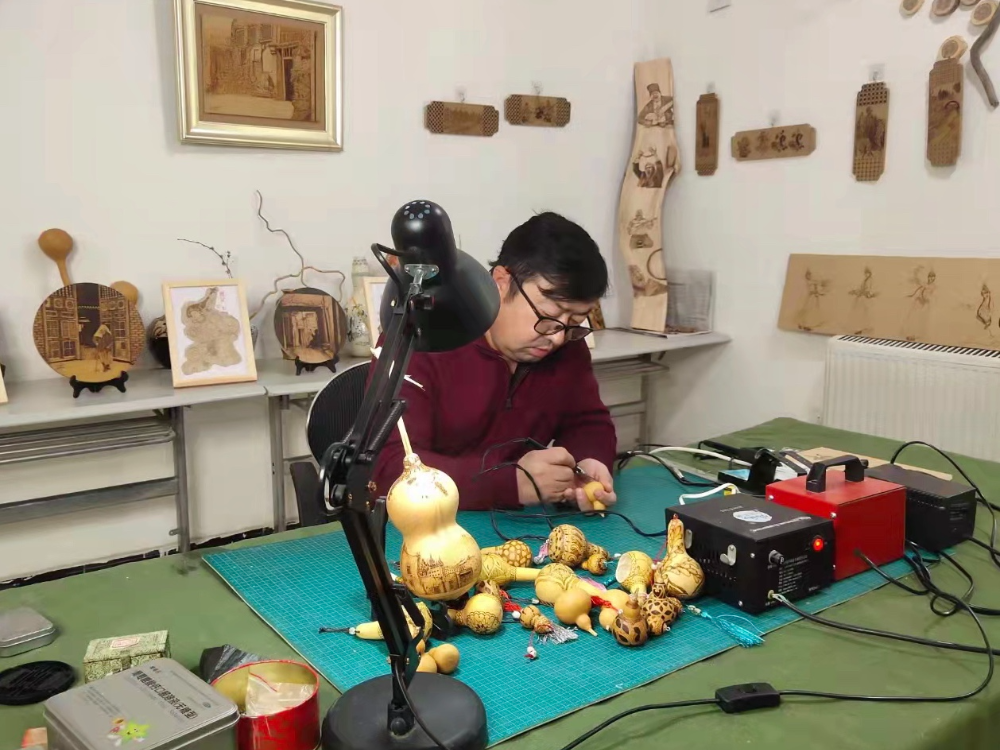
Keram Razak makes his pokerworks on gourds. [Photo/chinadaily.com.cn]
With great patience and focus controlling the heated tool on his hand, Keram Razak, a pokerwork artist from Northwest China's Xinjiang Uygur autonomous region, draws the beauty of his hometown on paper materials in the burning art form that never fades.
Keram, 49, is an inheritor of the intangible cultural heritage pyrography in Xinjiang's Turpan. Pyrography is the art of burning images into wood or other materials with heated tools, such as a poker or soldering iron. It has been practiced since ancient times.
As more efforts were made to protect intangible cultural heritage, Keram was invited in 2019 to open a studio in Grape Valley, a tourist attraction in Turpan, a city famous for its grapes.
Apart from common wood blocks and gourds with their surfaces decorated using the handicraft, his studio displays a number of pyrograph works made on mulberry paper that are mounted in frames.
Keram creatively made his pokerworks on local mulberry paper, which is crafted from the mulberry tree and famous for its durability. The handmade paper is a time-honored handicraft of the Uyghur people in Xinjiang and also an intangible cultural heritage.
In May this year, he went to a six-day mulberry paper workshop to learn the whole process of making the paper. He has been drawing on mulberry paper for more than two years.
"It was no easy task to turn the inspiration into reality," he said, adding it requires strict temperature control on mulberry paper, which is thinner than traditional materials and can be easily burned through if it is overheated.
Keram managed to present ancient Buddhist murals from local Buddhist grotto ruins in Xinjiang. "I want to combine local mulberry paper with local murals in Xinjiang," he said.
After going to the Buddhist grotto several times to observe the characteristics of the murals and reading historical books, he completed a series of Buddhist portraits with various expressions on the light brown mulberry paper using the delicate lines of pyrography.
Keram showed strong interest in art since childhood and is an art teacher in Turpan. During a teaching training program in 2007 in Tianjin, he came across a pokerwork in a market there and was immediately intrigued by the special drawing tool and the realistic patterns on pictures.
He then started to learn pyrography by reading books and watching teaching videos. "There were lots of failures at first, such as wrong strokes and burned papers," Keram said. It takes him two to three months to finish a piece.
He prefers drawing with Xinjiang characteristics, so he travels to various places in Xinjiang every year to find inspiration. "About thirteen or fourteen times a year, two to three days each time," he said.
Xinjiang's customs glow through Keram's delicate works, such as a joyful man playing a local folk musical instrument, the rawap, a smiling Uyghur girl, and an elder holding a naan, Xinjiang's flat bread.
An elder's portrait, called Grandpa is his favorite. The Uygur man was photographed by a friend of Keram's on a street in Kashgar, Xinjiang. His slightly frowning brows and deep wrinkles touched Keram deeply. He quickly devoted himself to the work.
The piece took him 20 days. "I spent a whole week just to draw his eyebrows," he added.
"Every time I get tired, I will look at him. No matter from which angle, he always looks at you," Karem said. The piece gave him comfort and inspiration.
Keram loves spreading Xinjiang culture and often participates in local festive activities and cultural exhibitions. He also displays his work on social media.
"I want to use this burning art to appreciate the beauty of life and show Xinjiang's cultural legacies to the world," he added.
Lu Wenjie and Mei Shajing in Turpan contributed to this story.








